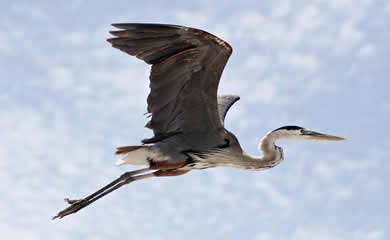“That blasted crane is fishing in my pond again,” I heard my father say. I have corrected him many times, but he still refers to the great blue heron as some kind of crane. Many wildlife viewers do not realize that herons and cranes are different species of birds. Most pond owners just want the birds out of their ponds and off their property.
Many species of herons are found in the Southeast, but only two species of cranes. Herons are usually seen in ponds or creeks, while cranes are found in agricultural fields.
One of the most common herons in the Southeast is the great blue heron, a medium-sized wading bird with long legs, a sharp pointed bill and a long neck. It is frequently seen in shallow water areas like creeks, riversides, swamps and farm ponds. Herons typically feed on small fish, frogs, insects, crayfish and salamanders.
Juvenile great blue herons are mostly white and gradually turn gray as they mature. One distinguishing characteristic is the S shape their neck forms while flying. Other common herons include the green heron and great egret.
 Both the whooping crane and the sandhill crane are sometimes seen in Alabama during the winter months.
Both the whooping crane and the sandhill crane are sometimes seen in Alabama during the winter months.
Sandhill cranes are gray in color, which may explain the common confusion with great blue herons. Whooping cranes are almost solid white except for their black wing tips that are exposed while flying. Cultivated grains make up the majority of a crane’s diet. The neck of a crane is much shorter than a herons’ neck. Cranes fly with their necks in a straight position.
Cranes and herons may look very similar, but pay attention to the type of habitat you see them in, and with practice and assistance from a bird field guide, distinction will become like second nature.
Hunting of either species is not allowed in Alabama.
Read more about the great blue heron and cranes and herons at
http://www.outdooralabama.com/great-blue-heron
http://www.outdooralabama.com/sandhill-crane
– Contributed by Brandon Howell, Area Wildlife Biologist, Alabama Division of Wildlife and Freshwater Fisheries
– Photos: Courtesy of the U.S. Fish and Wildlife Service